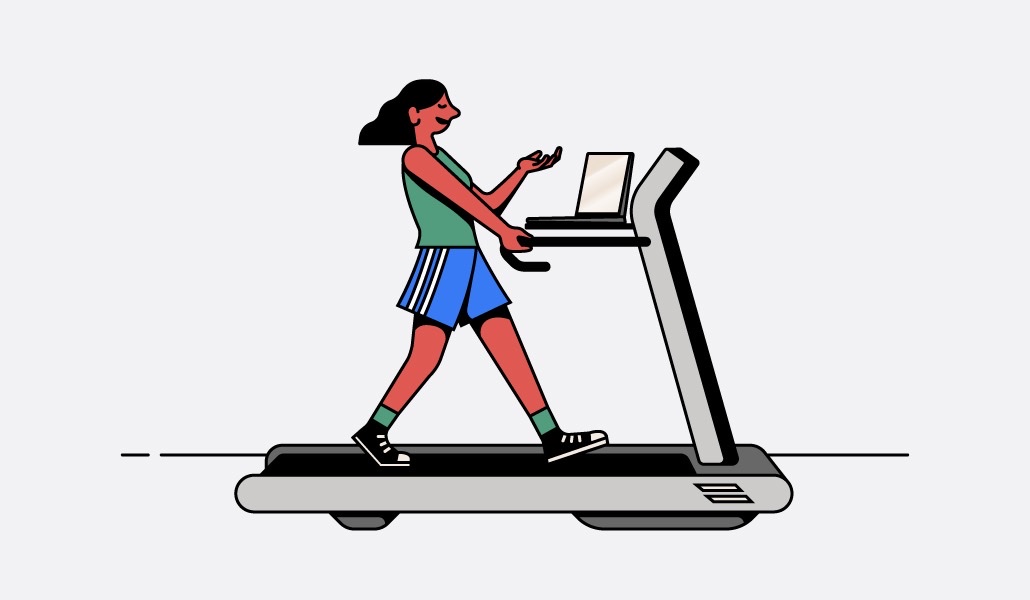Walking and working: Benefits of the treadmill desk

There’s the standing desk, and then there’s the treadmill desk for workers looking to take it up a notch.
Raegan Poltrock, a client strategy associate at advertising service Attentive, walks 10 to 20 miles a day with her GoYouth treadmill from Amazon. She started a year ago and has since noticed not just physical benefits but mental health ones, that have made her more productive at work.
“I love working from home,” said Poltrock. “But soon after I started, I realized just how little movement I was getting. I was starting to crave to move my body and I knew people had to feel the same way I was.”
After a quick Google search, she learned about a desk treadmill and decided to invest in it.
Treadmill desk users like Poltrock often report higher energy and increased productivity. While it isn’t necessarily a new interest, it has drawn in more people who are looking to step up their work-from-home setup while being mindful of their health.
The benefits of the treadmill desk are backed by studies like one headed by Dr. James Levine at Minneapolis-based consulting firm Salo. For six months, employees rotated on and off the desks, walking an average of three hours per day. Employees reported cholesterol decreasing in that time and the team being more productive.
Poltrock began with two to four miles on the treadmill a day.
“I started off super slow and steady,” said Poltrock. “I wanted to make sure I was comfortable.”
Now, she’s on it for nearly her full eight-hour day, which came after a year of walking and working to build her endurance over time. However, she makes sure to listen to her body and take breaks when she needs to. She said her typing has not been impacted and her workflow hasn’t changed.
Poltrock has also recorded her physical results since she started walking, via blood results. Similarly, her cholesterol levels have dropped, her thyroid health is in better shape, and so are her blood pressure levels.
“It’s been kind of mindblowing,” said Poltrock. “I haven’t changed anything else. None of my eating habits have changed, if anything I’m eating more now than I did before. I need to fuel my body when I walk this much.”
She’s been walking 20,000 steps a day — that’s double the recommended minimum of 10,000 steps a day by the Centers for Disease Control and Prevention. A study from the American Psychological Association found that those who walked during their work day had higher satisfaction and experienced less boredom and stress than those who were still.
Poltrock saw the same mental health benefits. Her focus, productivity, and motivation were all increased.
Her favorite part? She doesn’t need to find time before or after her work day to hit the gym, and that opens up time to prioritize other things instead, like hanging out with friends and family.
“This could work for somebody who has a family and kids and they need to, for example, tend to dinner after work,” said Poltrock. “There’s so many things we have to try to fit in. By doing this, you crank out that cardio and don’t have to worry about it when you’re done with work.”
Poltrock has shared her treadmill desk life on TikTok, where she’s had three videos go viral, together accumulating nearly 10 million views. Her setup includes her $400 under-the-desk treadmill, a $250 height-adjustable standing desk, and a $30 ergonomic laptop stand.
While she has her own DIY setup, purchasing the desk and the treadmill separately, there are companies who sell it all in one, like LifeSpan, Fully, and Costway.
For those back in the office, or in a hybrid setting, evidence shows that going outside to exercise during the day in natural settings, like for a walk in the park, can be beneficial to our mental health and cognitive ability, while also getting in additional steps.
“Anybody who is doing any kind of movement during the day, whether it’s on a treadmill or taking a walk, especially when you’re doing aerobic activity, what you’re doing is releasing a lot of different brain chemicals, which boost three things: mood, memory and learning,” said Lorne Opler, a Professor of Fitness and Health Promotion at Georgian College, in Barrie, Ontario Canada and a certified strength and conditioning specialist with the National Strength and Conditioning Association. “All three things are related to the work day.”
Aerobic exercise releases three things: endorphins, serotonin and brain-derived neurotrophic factor (BDNF), a brain protein that addresses memory and learning.
“You’re setting yourself up for a very productive afternoon because you’re releasing these chemicals,” said Opler. “You’re not only releasing these chemicals, which create a sense of calm and chill and feeling of relaxation, but you’re also preventing the mid-afternoon slump that you can get around 2 or 3 o’clock by exercising around lunchtime. Even if you don’t have a treadmill desk, doing something around the lunch hour will absolutely help your productivity.”


